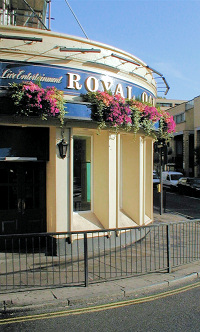Royal Oak
Royal Oak, Westminster
An ‘improving area’ (according to estate agents) situated in the locality once known as Westbournia

The Royal Oak public house stood at the southern end of what is now Porchester Road (formerly Celbridge Place) from at least the 18th century.
In the late 1830s the Great Western Railway line split this part of the Paddington district into northern and southern halves, reinforcing an existing distinction between the wealth of Bayswater to the south and the relative deprivation of Westbourne Green’s canalside streets to the north. The land here was owned at that time by one William Penney, who made a high compensation claim for his loss.
A little-served railway halt at Royal Oak brought some more industry and poor housing to the vicinity. There were pleasure gardens at the Royal Oak in the 1840s and most of the neighbouring locality was built up around this time.
Completed between 1855 and 1858, Porchester Square was one of the last parts the area to be developed. The Porchester name derives from one of the Hampshire estates of the Thistlewaite family, who had been among the chief lessees of the bishop of London’s land in Paddington for more than a century.
The Hammersmith & City Railway came through here in 1864 and its Royal Oak station was built on the site of William Penney’s house seven years later, whereupon Great Western Railway services were withdrawn.
In 1929 the construction of the hall, library and Turkish baths at what is now called the Porchester centre provided a valuable amenity and raised the tone of the area. Unusually for what is now styled an ‘events venue’, Porchester Hall has performed much the same role throughout its existence – though it presently hosts more weddings than whist drives. The centre’s Historic England listing was upgraded from II to II* in 2019.
Paddington borough council bought Porchester Square gardens and opened them to the public in 1955. The construction of the elevated section of the Westway compounded the area’s north–south division in the mid-1960s.
At the corner of Bishops Bridge and Porchester Roads, the rebuilt Royal Oak pub has been renamed the Porchester. Having acquired a very rough reputation under its former identity, the pub is now described by its management as bright and colourful, with “a hint of old Victorian playfulness.”
A Costain–Skanska joint venture constructed the Royal Oak portal in 2010-11 as the western tunnel entrance for Crossrail. The first two tunnel boring machines, Phyllis and Ada, began tunnelling from Royal Oak towards Farringdon in 2012.
The novelist Thomas Hardy lived briefly at No.4 Celbridge Place (later Porchester Road) in the early 1870s.
The Royal Oak murals were painted in 1976–7 beneath the Westway, just north of Royal Oak tube station, by David Binnington and Desmond Rochfort. Blogging for the London Mural Preservation Society, Ben Kaufmann declares that they “stand as testaments to a not so distant (but rather short lived) age of large scale, ideologically charged, political murals.”
